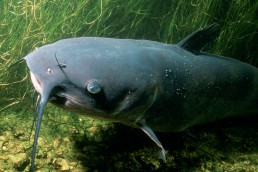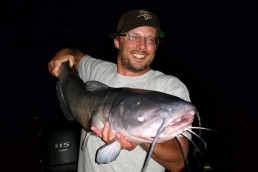Jugging for Cats
SHARE THIS POST
There are many methods that catfishermen employ to catch a nice mess fish. I’ve tried using everything from trotlines, bank poles and yo-yo’s and have done hook-and-line fishing from the bank or a boat. But one of my favorite methods is using jug lines.
Many people ask me why I use jug lines more now. The answer is a simple: I catch a lot of fish, it’s exhilarating, and not many others use this method. I know my last reason might not be a good one, but I do like to be different. If I’d have to give one reason why I like jug lines it would have to be because it’s the easiest way to catch catfish.
Jugging for cats offers the ability to catch fish that aren’t on the bottom. Many have the misconception that the only way to catch these fish is off the floor. The truth is many catfish are suspended well off the bottom. The jug lines offer the same concept as fishing with a bobber where the bait is suspended a short distance from the bobber, or in this case, the jug.
I keep empty 2-liter pop bottles and milk jugs and spray-paint orange on them so I can locate them. Then I store these in a garbage bag. For line, I’ll use a 10- to 15-foot piece of nylon cord, It’s the same type I use when making trot and turtle lines. I tie one end to the neck of the pop bottle or to the handle of the milk jug. For hooks, I prefer a 2/0 trotline hook. Then I’ll attach a sinker 8 inches above the hook. Depending on the water conditions, the size of weight used can vary. Obviously, it will take a heavier weight when there is a lot of current.
Are you enjoying this post?
You can be among the first to get the latest info on where to go, what to use and how to use it!
The best method for keeping the line at the desired length from the jug is using a rubber band. Run the desired amount of line you want below the jug and attach the remainder to the jug by wrapping a rubber band around it. This is also a good way to safely transport your jugs. Always remember to keep the bait a good distance from the bottom, as fishing here will defeat the purpose of using jugs in the first place. You want the jugs to be able to move with the current and a line dragging the bottom will prohibit this.
It doesn’t matter if the water is moving or is virtually calm, jugs work well in either condition. When setting jugs on a lake, I prefer to find a bay away from the boat traffic and set them in a circular shape. I don’t need other boaters running over my gear and I’m sure they wouldn’t be too happy to have their prop tangled with a heavy nylon line. In rivers, simply toss jugs about 15 feet apart from one another and allow them to drift with the current close to a bank with laydowns. Other good locations for the jugs are gravel bars. It’s easier to set all of your jugs on the same side of the river too, as this will make them easier to retrieve and to keep an eye on while you’re drifting along “fishing.” Never set out more jugs than you can control and never leave them in the water unattended. Always take them with you when you’re done for the day. To retrieve your jugs, either when you have hooked a fish or when you’re finished, use a metal gaff hook attached to an old broom handle to hook the line and pull it in.
I can’t think of a better way to spend a lazy summer July afternoon than fishing with jugs. Give it a try. You might just wonder why you haven’t given it a chance before.
MWO
SHARE THIS POST
Did you enjoy this post?
You can be among the first to get the latest info on where to go, what to use and how to use it!
Jason Houser
Jason Houser is an avid outdoorsman from Central Illinois. Houser has been a full-time freelance writer since 2008. He is also the host of Jason Houser Outdoors, airing on the Hunt Channel. He can be found on Facebook at Jason Houser Outdoors or on the web at jasonhouseroutdoors.com.



